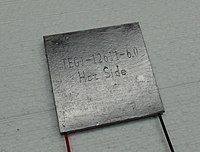
Photo from wikipedia
Background Apical sparing of left ventricular (LV) strain can occur in light-chain cardiac amyloidosis (AL-CA). We employed indicators of the strain ratio of the apex to base (RAB) and the… Click to show full abstract
Background Apical sparing of left ventricular (LV) strain can occur in light-chain cardiac amyloidosis (AL-CA). We employed indicators of the strain ratio of the apex to base (RAB) and the relative apical sparing of strain (RAS) on the basis of LV global and segmental strain to distinguish AL-CA from hypertrophic cardiomyopathy (HCM). Methods In all, 36 AL-CA patients, 37 HCM patients, and 36 healthy controls underwent 3.0 T cardiac magnetic resonance (CMR) examination. We compared LV strain parameters from CMR tissue tracking (CMR-TT), including global and segmental peak radial strain (PRS), peak circumferential strain (PCS), and peak longitudinal strain (PLS); the peak systolic strain rate in radial, circumferential, and longitudinal directions (PSSR_R, PSSR_C, PSSR_L); and the peak diastolic strain rate in radial, circumferential, and longitudinal directions (PDSR_R, PDSR_C, PDSR_L). We also assessed the values of RAB and RAS. Differences in all groups were compared using an independent t-test and a nonparametric rank sum test. Results In the comparison of global strain parameters, all the peak strain, systolic, and diastolic peak strain rates of the AL-CA group significantly decreased compared with those of the HCM and healthy control groups (all P<0.001). The values of PSSR in all directions were lower in the AL-CA than in the HCM patients (PSSR_R, P<0.001; PSSR_C, P=0.004; PSSR_L, P=0.010) . In the analysis of segmental strain parameters, all peak strains in the basal segment showed significant differences between the AL-CA and HCM groups (all P<0.001). Some strain rate parameters in the basal segment were also noted to be significantly different (PSSR_R, P<0.001; PSSR_L, P<0.001; PDSR_R, P=0.015; PDSR_C, P=0.020). Both the RAB and RAS of peak strain in all directions showed significant differences between the AL-CA and HCM groups (all P<0.001). The RAB of the radial and circumferential PSSR showed statistical differences between the 2 groups (P<0.001 and P=0.001). The RAS in the radial direction of both the PSSR and PDSR was statistically different (P=0.003 and P=0.012). Conclusions The CMR-TT technique can be used to quantitatively compare global and segmental strain differences between AL-CA and HCM. In addition, RAB and RAS are reliable parameters for assessing the apical sparing pattern and thus, for distinguishing AL-CA from HCM.
Journal Title: Quantitative Imaging in Medicine and Surgery
Year Published: 2022
Link to full text (if available)
Share on Social Media: Sign Up to like & get
recommendations!